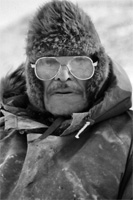Osuitok Ipeelee facts for kids
Quick facts for kids
Osuitok Ipeelee
|
|
|---|---|
 |
|
| Born | October 23, 1923 Neeouleeutalik camp
|
| Died | 2005 |
| Known for | sculptor |
Osuitok Ipeelee (born September 23, 1923, died 2005) was a famous Inuk artist. He was known for his amazing sculptures. Osuitok lived in a place called Cape Dorset in Nunavut, Canada.
His sculptures were often made from green soapstone. He was especially good at carving caribou and birds. People loved his art because it looked balanced and delicate.
Osuitok worked closely with James Archibald Houston. He helped start the West Baffin Island Eskimo Cooperative. This group helped Inuit artists share their work.
Contents
Osuitok Ipeelee's Life Story

Growing Up and Early Art Skills
Osuitok Ipeelee grew up in a traditional Inuit way of life. He lived in a small camp near Cape Dorset. His father, Ohotok Ipeelee, taught him how to hunt and fish.
His father also taught him how to carve ivory. Osuitok started sculpting when he was only thirteen years old. Catholic missionaries encouraged his art. They bought his carvings and asked him to make small crucifixes.
His earliest artworks that we know of are small ivory carvings. They show hunting tools from the 1940s. These pieces are typical of early Inuit art.
Working with James Houston
Before 1951, Osuitok was already known as the best carver on Baffin Island. This was even before James Houston arrived. Houston helped him start carving with soapstone. Soapstone carvings were popular and easy to sell.
Osuitok's art was shown in big exhibits. His work was at the National Gallery of Canada in 1952 and 1955. He became known as "Oshaweetuk B" in these shows.
As he became more famous, he received special requests. In 1955, he led a team to create the official mace. This mace was for the Council of the Northwest Territories. In 1959, he made a sculpture of Queen Elizabeth II. This sculpture was given to the Queen when she visited Canada.
How Inuit Printmaking Began
The idea for a printmaking program in Cape Dorset started in 1957. James Houston and Osuitok Ipeelee were talking one winter.
Houston remembered Osuitok looking at cigarette packages. Each package had the same sailor-head picture. Osuitok thought it must be tiring to paint so many tiny, identical heads.
Houston tried to explain how printing worked. He saw an ivory walrus tusk that Osuitok had carved. Houston took some black ink and spread it over the tusk. He then placed a piece of toilet paper on the inked surface. He rubbed it gently and pulled the paper off. A clear print of Osuitok's carving appeared!
Osuitok quickly said, "We could do that!" And that's how the idea for Inuit printmaking began.
Even though he helped start printmaking, Osuitok didn't make many prints. He only contributed four prints in total. He made two in 1958 and two in 1959. He later explained that he didn't feel he was paid enough for his drawings. He found that sculpting was more profitable for him.
Osuitok Ipeelee's Artworks
Famous Sculptures
- Harpoon Head Figure (1983), made from serpentine stone. You can see it at the National Gallery of Canada.
Prints He Created
- Musk Ox, 1958. This was a stonecut print.
- Weasel, 1958. Also a stonecut print.
- Four Musk Oxen, 1959. Made using stonecut and sealskin stencil.
- Owl, Fox, and Hare Legend, 1959. Made using stonecut and sealskin stencil.
Awards and Recognition
- He received the National Aboriginal Achievement Award in 2004. This award is now called the Indspire Awards.
- He became a member of the Royal Canadian Academy of Arts in 1973.

